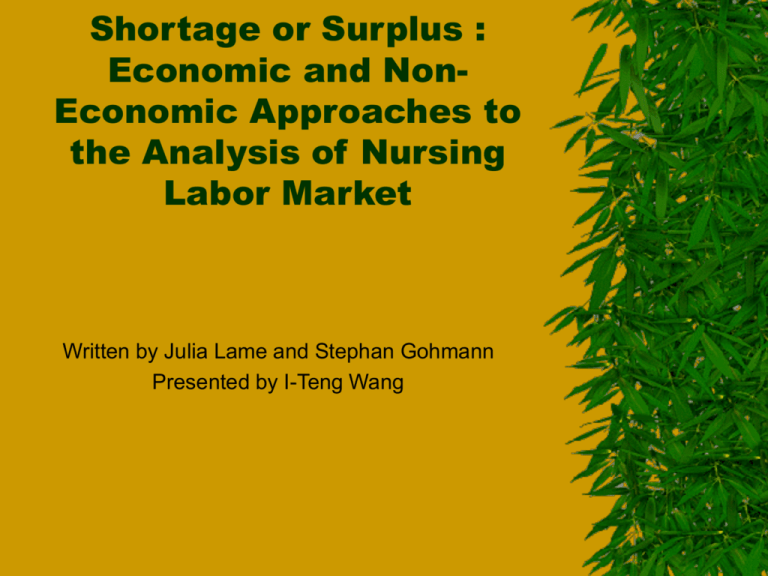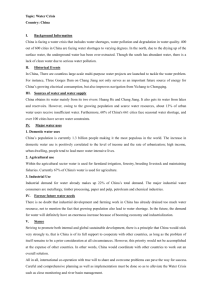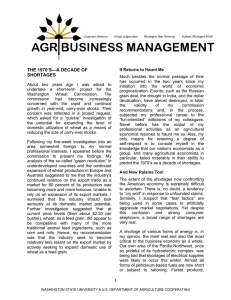Shortage or Surplus : Economic and Non
advertisement

Shortage or Surplus : Economic and NonEconomic Approaches to the Analysis of Nursing Labor Market Written by Julia Lame and Stephan Gohmann Presented by I-Teng Wang Introduction Medical professionals define shortages in two ways : Need-based Approach : Identifies the number of professionals needed to perform certain tasks based on the judgment of a medical profession Ratio Technique : Compares the current professional / population ratio to a projected future ratio, and identifies a difference as a shortage Economic Approach : Economists define shortages when quantity demanded is greater than the quantity supplied at the market price Alternative Approaches The Economic Approach The Non-Economic Approach The Office of Shortage Designations(OSD) uses a ratio technique to identify health professional shortage areas. The OSD calculates total nurse supply by adding up the number of full time equivalent nurses in short term general hospitals in a county. It then uses a fairly complex ratio technique based on the basic shortage criterion. Nurse shortages exist if the need based on this measure is greater than the fixed supply of nurses in the county Model The demand for nurse equation ln(FTENRS) = b0+b1ln(W)+b2ln(Poth)=b3ln(Q)+b4ln(MKTPOW)+e FTENRS : full time equivalent nurses W : wage Poth : the prices of other inputs include non-nurse labor(OTHWAG) and the price of capital(PKAP) Q : hospital services MKTPOW : hospital market power b1 < 0 & b3, b4 > 0 Model The supply of nurse equation ln(FTENRS) = c0+c1ln(W)+c2ln(Walt)+c3ln(AVAIL)+e Walt : the alternative earnings capacity of nurses include prevailing nurse wages in the remainder of the health service area(HWAGE) and the county per capita income(PCINC) AVAIL : the local availability of full &part-time nurses in the remainder of the health services area(HNURSE & FRACRN) c2 < 0 & c1, c3 > 0 Estimation Both equations were estimated as both a simultaneous model using two stage least squares(2SLS) and then as a switching model. A switching model here means if wages do not adjust then shortages & surpluses will occur and wages are exogenous to the model Results In a simultaneous 2SLS model The wage elasticity of demand is 1.14 Nurses and non-nurse labor are gross complements Nurses and capital are gross substitution Higher alternative wages in the region(HWAGE) reduce supply Higher numbers of part-time nurses(FRACRN) reduce supply Results In a switching model The parameter estimates are remarkably similar to the simultaneous model both in sign and in order of magnitude The relationship between nurses and other personnel is that of complements rather than substitutes The wage elasticity of demand now is 0.92 The elasticity of supply falls from 0.59 (2SLS) to 0.17 now Comparison of Outcomes between Economic and Noneconomic Approaches Variables Economic Shortage/OS D NonShortage Economic NonShortage/OS D Shortage T-statistic WAGE 16,429 25,594 12.44 HWAGE 21,506 22,270 2.92 PCINC 11,567 10,729 4.05 INFMRT 94.67 105.07 2.63 NURSE 7.70 6.19 3.26 Comparison Wage in the counties where the economic approach identifies shortages are $9165 ($25,594-$16,429) less on those counties identified as shortages by non-economic approach Economic shortage areas are those with higher per capita incomes (PCINC) and lower infant mortality rates (INFMRT) than OSD shortage areas Economic shortage areas trend to have lower alternative wages (HWAGE) than do the OSD shortage areas Summary The definition of shortages yields markedly different estimates between the economic and non-economic approaches. The noneconomic model places more counties as shortage areas than does the economic model. On the other hand, they agree in only 133 cases. This dramatic difference in results implies that both approaches to shortages must be recognized in the health care debate,else policy makers may act to alleviate shortages which do not exist









